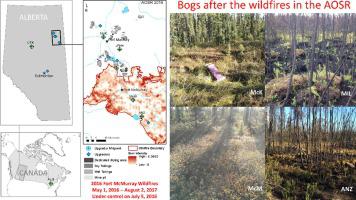Environment International ( IF 10.3 ) Pub Date : 2021-10-01 , DOI: 10.1016/j.envint.2021.106910 Yifeng Zhang 1 , Rick Pelletier 2 , Tommy Noernberg 2 , Mark W Donner 2 , Iain Grant-Weaver 2 , Jonathan W Martin 3 , William Shotyk 2

|
Fort McMurray and the Athabasca oil sands region (AOSR) experienced major wildfires in 2016, but the impact of these on regional deposition of polycyclic aromatic hydrocarbons (PAHs) and trace elements has not been reported nor compared to industrial sources of these pollutants in the region. Living moss (Sphagnum fuscum) was collected in triplicate from five ombrotrophic bogs in the AOSR after the wildfires, and analyzed for PAHs and trace elements. These post-wildfire data were compared to data from previous years at the same sites, and also to remote reference bogs in Alberta and Ontario. Elevated post-wildfire concentrations and flux of naphthalene and fluorene were observed at all five bogs in the AOSR, but no consistent trend was evident for higher molecular weight PAHs or the sum of priority PAHs (∑13PAH). Trace elements at most AOSR bogs were not elevated post-wildfire, except at one bog in the burned area (MIL), but even here the elements that were increased (1.7–5.6 × ) were likely of bitumen-origin (i.e., V, Ni, Se, Mo and Re). Significant post-wildfire correlations between PAHs and most trace elements suggested a common source, and few significant correlations were observed with retene, suggesting that wildfires were not the dominant source of most contaminants detected. Mass balance receptor models were used to apportion sources, indicating that the major sources of trace elements among five AOSR bogs post-wildfire were oil sands ore (mean 42%), haul road dust (17%), and petcoke (11%), whereas wildfire was always a minor source (3–4%). For PAHs at the most contaminated site (MIL), delayed petcoke (27%) and wildfire (25%) were the major sources, but the contribution of wildfire to PAHs at other sites was less or not discernable. Impacts of the 2016 wildfires on regional atmospheric deposition of major pollutants was less than from ongoing deposition of anthropogenic dust from oil sands activities.
中文翻译:

2016 年麦克默里堡野火对多环芳烃和微量元素大气沉积到周围营养沼泽的影响
麦克默里堡和阿萨巴斯卡油砂地区 (AOSR) 在 2016 年经历了重大野火,但这些对多环芳烃 (PAHs) 和微量元素区域沉积的影响尚未报告,也未与该地区这些污染物的工业来源进行比较. 野火过后,从 AOSR 的五个营养沼泽中采集活苔藓 ( Sphagnum fuscum ),一式三份,并分析 PAHs 和微量元素。这些野火后数据与前几年在同一地点的数据进行了比较,也与阿尔伯塔省和安大略省的远程参考沼泽数据进行了比较。在 AOSR 的所有五个沼泽中观察到野火后的萘和芴浓度和通量升高,但较高分子量的 PAH 或优先 PAH 的总和没有明显的一致趋势 (∑13多环芳烃)。大多数 AOSR 沼泽中的微量元素在野火后没有升高,除了在烧毁区域 (MIL) 中的一个沼泽,但即使在这里,增加的元素 (1.7-5.6 × ) 也可能来自沥青(即 V,镍、硒、钼和铼)。PAHs 与大多数微量元素之间的显着野火后相关性表明存在共同来源,而与 reten 几乎没有观察到显着相关性,这表明野火不是检测到的大多数污染物的主要来源。使用质量平衡受体模型进行来源分配,表明山火后 5 个 AOSR 沼泽中微量元素的主要来源是油砂矿(平均 42%)、运输道路粉尘(17%)和石油焦(11%),而野火始终是次要来源(3-4%)。对于污染最严重的地点 (MIL) 的 PAH,延迟的石油焦 (27%) 和野火 (25%) 是主要来源,但野火对其他地点的多环芳烃的贡献较少或无法辨别。2016 年野火对主要污染物区域大气沉降的影响小于油砂活动造成的人为尘埃持续沉降。











































 京公网安备 11010802027423号
京公网安备 11010802027423号